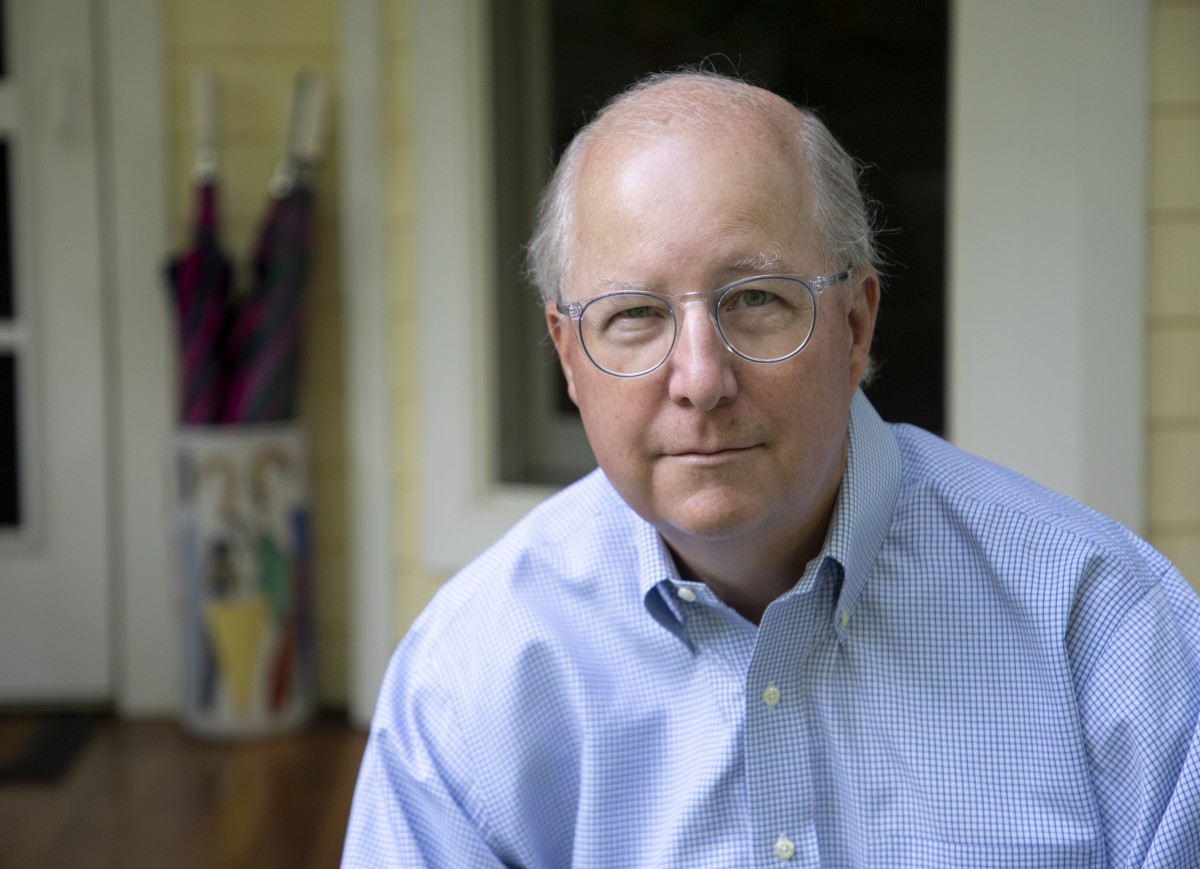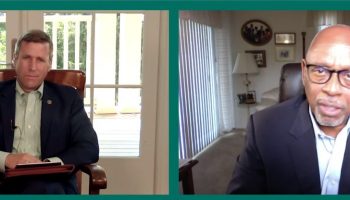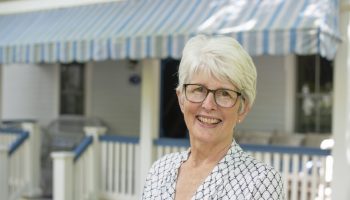As the fifth of his six seasons as chairman of the Chautauqua Institution Board of Trustees moves through Week Seven, Jim Pardo will again take the podium on Saturday morning on Aug. 11 at the Institution’s annual corporation meeting. And as with previous seasons, this past year has been a full one for Pardo, whose activism and engagement have become emblematic of his tenure as board chair.
With a new Institution president firmly in place and the transition period of significant senior staff turnover settling down, Pardo and his colleagues on the board of trustees have joined an effort to devise a comprehensive new strategic plan for Chautauqua, as well as a potential fundraising campaign to honor the Institution’s 2024 sesquicentennial and support the new plan. We spoke on Pardo’s porch near midtown.
Michael Hill has now been president of Chautauqua for over a year. What are your impressions?
Jim Pardo: It has been a pleasure to watch him in the job, and to observe what seems to be a high level of genuine contentment on the grounds. We — Michael, Laura Currie (chair of the Strategic Planning Working Group) and I — used our trustee open forum meeting July 14 for a community feedback session. At that meeting, only six audience members spoke up. We had budgeted over an hour for the meeting, and we exhausted the audience participation in 25 minutes. We saw that as an indication of satisfaction with how things are going. As you know, Chautauquans are not hesitant to approach me with their views on the course of events here, favorable or not. The feedback has generally been very positive.
Michael certainly seems to have hit his stride. He has experienced a full season before, so I see him pacing himself well and really hitting his stride in charge of an amazingly complex and diverse program. He knows you cannot go full bore every single moment and still have enough energy to stay fully engaged and on the job for nine straight weeks. He’s getting some regular exercise and affording himself a 15-minute break from time to time just to collect his thoughts. He’s doing really well.
Michael has successfully replaced some of his most senior staff. He knew he would need to replace George (Murphy, former vice president and chief marketing officer) and Sherra (Babcock, former vice president and Emily and Richard Smucker Chair for Education) and then Robert (Franklin, former director of religion) decided his commitments in Atlanta wouldn’t permit him to stay longer with us, so another vice president job came open. Emily Morris for George, Dave Griffith for Sherra and Gene Robinson for Robert are all thoroughly on the job. Staff holdovers from Tom Becker’s senior staff seem to have embraced their new colleagues, and I sense a high level of productivity on the administration staff. Michael told us during the presidential search that his philosophy was to hire good people and get out of the way and let them do their work. He’s clearly doing that.
If there is a surprise, it is how quickly in his tenure Michael realized the need to simultaneously tackle a lot of tough issues. For some of these issues, he’s using consultants, which the board applauds. His work on the lakefront and golf course management plans, on security and on diversity and on philanthropy, feeding into a strategic planning process, is really significant in my mind. He recognized all were overdue and simply got down to pursuing policy options for each, rather than doing them one or two at a time. I’ve been around the board for a long time now, and I’m not sure I would have identified every issue he has concentrated on. But there’s no doubt he has prioritized very well.
On the strategic plan, there are a lot of critical components. You mentioned many of them. Who identified the most important issues?
For me, the elements we have talked about needed to be done not because of the development of the strategic plan, but because they needed to be done, period. The coincidence of our developing a strategic plan is serendipity. The consultants are synthesizing community input for us, and that stream is like others such as Chautauqua Foundation board, or board of trustees or staff input.
Michael and I devised the structure of the strategic planning committee one-on-one. We wanted very much for this process to represent a combined board of trustees-administration vision. The way to do that was to have a working group drawn from both groups. We wound up with four trustees (three currently active, one retired), one foundation director and several of Michael’s staff in a substantive role and others more in support. Counting Michael, that’s 11 of us on the working group.
Over the years, the Institution has varied in its approach on the use of outside consultants. But Michael agreed that since he is relatively new here, using consultants made sense in this case.
To answer your question, though, our consultants have left at least 75 percent of the information gathering to us. So we — the trustees and foundation director and the administration, with significant community input, have been taking the lead on issue identification.
You’re currently still gathering information.
Yes. You know about our Thursday afternoon sessions at the Hall of Christ. The consultants are still working with all the input we are receiving. Our committee will go to work in earnest in September and October with all the data that has been gathered. In November, we will give to the board a broad outline to look at. By the time of the February 2019 board of trustees meeting, it is our intention to develop a cogent draft (of the) strategic plan.
The board of trustees will comment, critique and change at the February meeting. We will synthesize this feedback and have a strategic plan ready for board approval in May of next year. By that time, more than a year of information gathering, effort and analysis will have contributed to the plan’s development.
It is important to remember that once a strategic plan is approved, that action does not signal the end of planning and development on several issues we are addressing concurrent to the planning process. Broadening Chautauqua’s diversity is just one example of this; that process will be ongoing.
So in nine months, we will likely have a new strategic plan for the Institution. It seems reasonable to assume that a fundraising effort will follow to support the plan.
It’s a truism in the nonprofit world that a capital campaign will follow a strategic plan. The strategic plan is not intended to direct or mandate a capital campaign in this case. A major fundraising effort may indeed ensue, but those decisions have not yet been made.
There are actually two major anniversaries coming up. 2023 is the sesquicentennial of the first gathering on the grounds, and the following year of course is the 150th anniversary of the founding of Chautauqua Institution. It’s fair to say that there is as yet no consensus on timing, goals or indeed the form of any further fundraising campaign. We’re in a relatively quiet period on the fundraising front right now, after the highly successful Promise Campaign.
Let’s talk about the Thursday sessions you, Michael Hill and Laura Currie are holding in the Hall of Christ. You obviously want input on big issues for Chautauqua. How has been the community’s response so far?
I have been very pleased so far. We have gotten solid, candid, helpful responses. A lot of off-season work preceded this summer’s Thursday sessions. I think Michael had 15-18 sessions around the country with groups of Chautauquans. We did an aggressive email solicitation of views. We have been running focus groups based on known, specific issue engagement by Chautauquans.
The other day, for example, we spoke with a group who had come to Chautauqua for the first time last year and returned in 2018. And we’ll run our Thursday sessions until the end of the season. We’re reaching out to thought leaders at other, comparable organizations. We’re trying to reach as broad a cross-section of individuals as is possible. I think we’re doing well on information gathering.
Do you think the community acknowledges your and the group’s efforts to engage with it?
I’m not sure what more we could have done on engagement. I don’t mean that to be a defensive answer, just an honest one. I know community engagement was a high priority for all of us who were involved.
I will say this. I do think the era of relative good feelings we are experiencing on the grounds this summer does flow to some degree from the successful completion of the Amphitheater project. Chautauqua Institution proved itself capable of delivering on the new Amp. This gives a renewed, positive vigor to relations with the community. There’s a better comfort level in general on the grounds, and I believe that this fact impacts the good input we are getting on the strategic plan.
I will also say there is obviously a lot of creative vigor on the grounds, and I think people recognize this. We’re into something that might be pretty significant.
Are we in the midst of change?
Well, I still look at Chautauqua through the lens of the board of trustees, so I continue to fret about the long-term financial sustainability of the Institution. In the short-term, we look OK at this point. We have a business model that’s working. We are supported by philanthropy that, thank goodness, continues to keep coming in year after year. As we sit here today, the Institution is in the strongest financial position in its history.
That financial stability gives the Institution the ability to look at and reflect on change. Change is good. I’m sure the last buggy whip maker in the U.S. wished he had changed his business model before it was too late. Some change, if not handled well, could be problematic. I think the changing demographics of this place dictate the need for the Institution to change, programmatically at least. We have to provide what we call a mix of programming every week to ensure that everyone has a first-rate experience and considers returning.
We have to deal with the reality of visits of one week and even less. This compels a flexibility and need to offer various programming every single week of the season. So changes do appear in the way we organize our programming across venues and departments.
And we have to be nimble and responsive in other ways. Look at the new Dr. Robert R. Hesse Welcome and Business Center in the Main Gate building. We were told by NOW Generation Chautauquans that this was needed. Data I have seen show its success. No one ever said this business of Chautauqua Institution was easy, but I like to think we’re holding our own as the challenges roll in.






